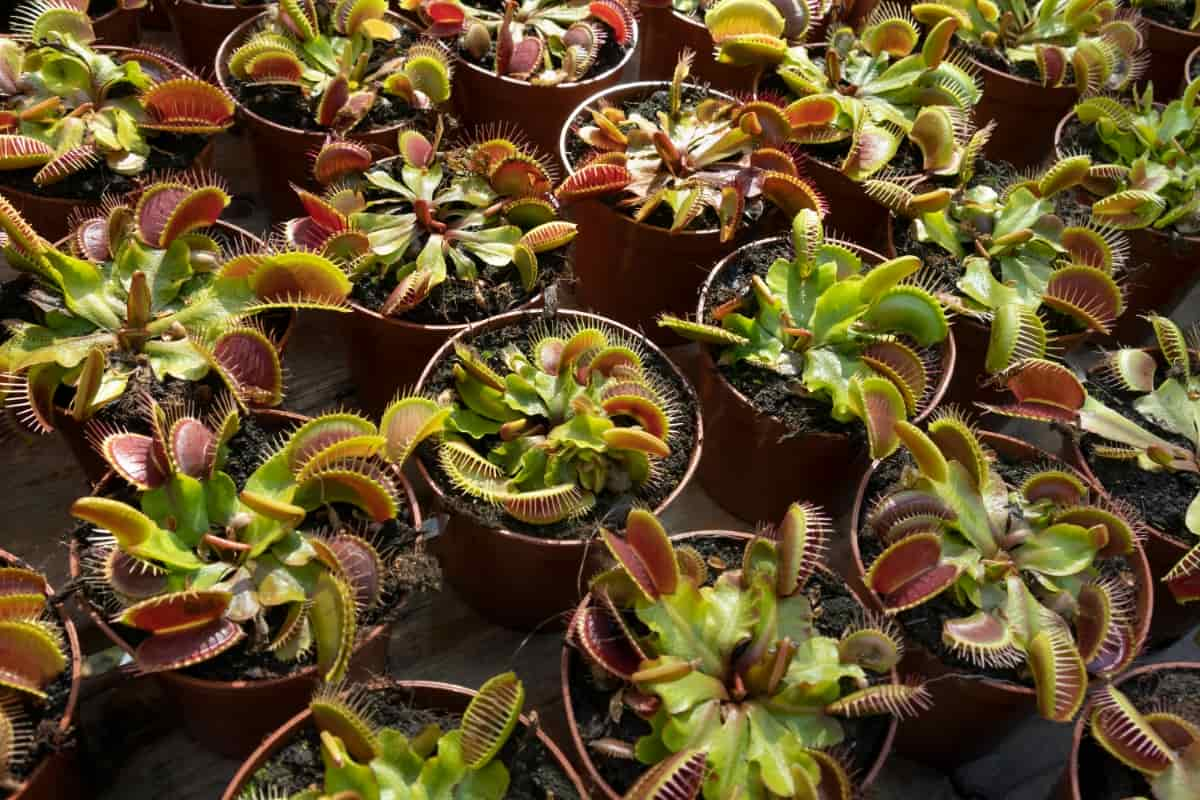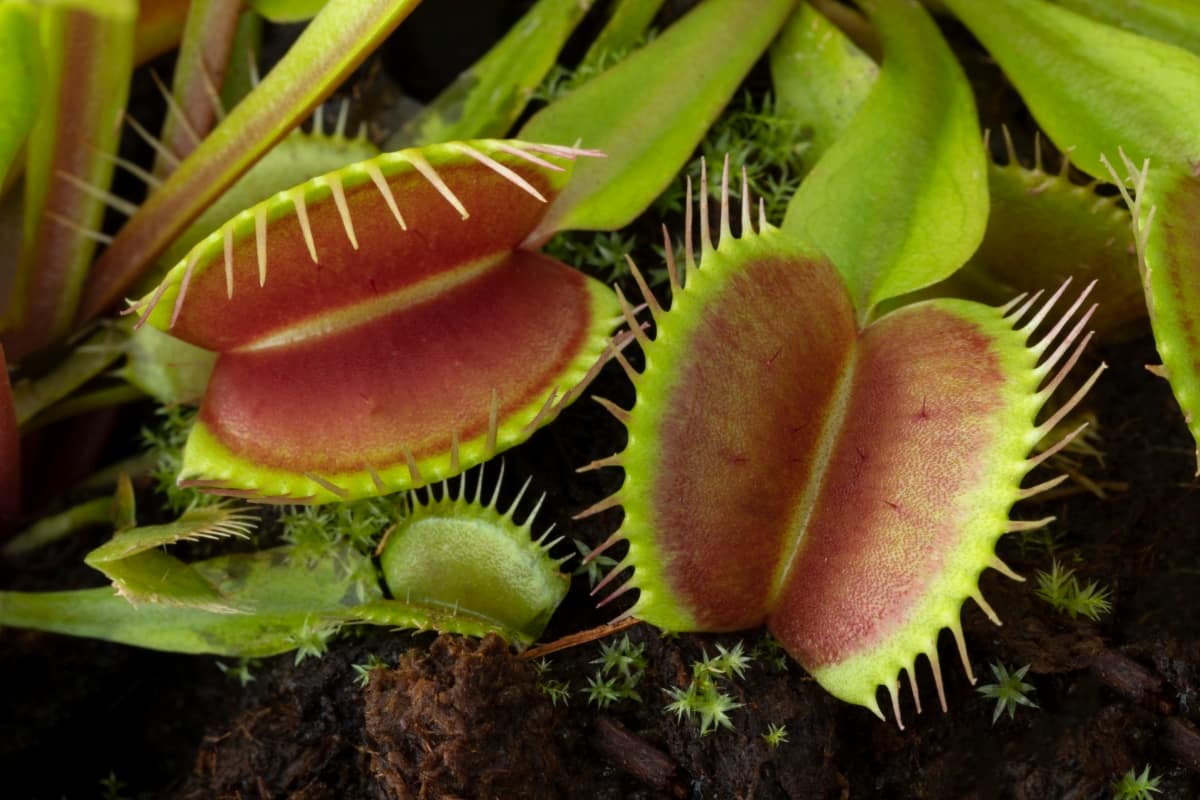Growing the captivating Venus Flytrap indoors is a fascinating endeavor that combines the allure of nature’s raw predatory mechanisms with the convenience of indoor gardening. Originating from the subtropical wetlands of the United States, the Venus Flytrap has become an emblematic representation of carnivorous plants, famed for its modified leaves that snap shut to trap unsuspecting insects.
With an increasing number of enthusiasts keen to explore how to grow a Venus flytrap from seeds, how often to feed Venus fly trap, what to feed a Venus fly trap indoors, and how to care for the Venus fly trap in winter, understanding the intricacies of its care becomes paramount.

Questions like “Do Venus fly traps need water?” or “What kind of fertilizer should I use for my Venus flytrap?” underline the plant’s unique needs, setting it apart from standard houseplants. As we dive deeper into the world of Venus Flytraps, one can’t help but marvel at the wonder of its existence and the promise it holds for indoor gardeners seeking something out of the ordinary.
How to Grow Venus Flytrap Indoors
Understanding the Venus Flytrap Plant
The Venus Flytrap is an intriguing insect-eating plant indigenous to the subtropical wetlands of the United States. As its name suggests, it lures, captures, and consumes insects using its unique modified leaves, which form a trap. Many individuals wonder how to grow Venus flytrap indoors, as its intriguing feeding mechanisms and vibrant appearance make it a popular houseplant.
Growing Venus flytraps from seeds, understanding how often to feed Venus flytraps, and discerning the best care for the plant in winter are essential components of indoor cultivation. Proper attention to care aspects like watering, as one might ponder, “Do Venus fly traps need water?” and the type of fertilizer suitable for the plant, “What kind of fertilizer should I use for my Venus flytrap?”, can ensure its healthy growth indoors.
Propagating Venus Flytraps: Step-By-Step Methods for Successful Reproduction
Propagating the Venus flytrap offers an economical means to expand your collection. The most common method is by seed. Starting the process of how to grow Venus fly trap from seeds begins with obtaining fresh seeds from mature plants. Place the seeds in a stratification process by refrigerating them in damp sphagnum moss for about 4-6 weeks. After stratification, sow them in a suitable carnivorous plant soil mix. Within a few weeks to several months, seedlings will emerge. Patience is key; it answers how long it takes for a Venus flytrap to grow from seed.
Planting Venus Flytraps Indoors: Choosing the Right Container and Soil Mix
Your container and soil choice can determine the success rate when considering how to grow a Venus flytrap indoors. A plastic pot with drainage holes is ideal. The Venus flytrap requires a well-draining soil mix that’s low in nutrients. An optimal blend consists of equal parts of peat moss and either perlite or sand. Avoid garden soil or potting mixes with added fertilizers, as these can harm the plant.
Providing Optimal Care for Indoor Venus Flytraps: Light, Temperature, and Humidity Requirements
A vital component of indoor cultivation is ensuring the Venus flytrap receives adequate light. Position the plant close to a south-facing window to receive 4-6 hours of direct sunlight every day. Maintain a daytime temperature range of 70-95°F and a minimum of 55°F at night. To provide adequate humidity, consider using a humidity tray or a room humidifier in proximity to the Venus flytrap’s pot.
In case you missed it: How to Grow Plumeria from Cuttings: Best Practices for Potting and Transplanting

Watering Venus Flytraps: Best Practices for Maintaining Proper Moisture Levels
Watering is integral to care, addressing the question, “Do Venus fly traps need water?”. These plants prefer moist soil. Always use distilled water, rainwater, or reverse osmosis water, as tap water can have minerals harmful to the plant. The tray method, where the pot sits in a tray filled with water, ensures the plant receives consistent moisture without becoming waterlogged.
Feeding Venus Flytraps: What to Feed Venus Fly Trap Indoor and How Often to Feed Venus Fly Trap
For those wondering what to feed Venus fly traps indoors, it’s essential to understand that they can survive without food, deriving nutrients from the soil. However, feeding them insects like flies or small spiders every 2-3 weeks is beneficial for better growth. Never feed them human food or meat. When determining how often to feed Venus fly trap, once or twice a month is adequate.
Dormancy Period for Venus Flytraps: How to Successfully Induce and Manage Winter Rest
The Venus flytrap experiences a dormancy period in winter, akin to hibernation. Learning to care for the Venus Fly trap in winter is crucial for survival. During this period, reduce watering and allow the soil to dry slightly. Place the plant in a cooler area, ideally between 35-45°F. Reduce sunlight exposure, and avoid feeding during this phase.
Common Pests and Diseases of Indoor Venus Flytraps: Identification and Control Measures
Like any indoor plant, Venus flytraps are susceptible to pests and diseases. Spider mites, aphids, and fungus gnats are common pests. Insecticidal soaps or neem oil can combat these. Root rot, a disease resulting from overwatering, can be avoided by ensuring proper drainage and allowing the soil to dry slightly between waterings.
In case you missed it: How to Grow Succulent Seeds: Easiest and Fast Growing Succulents from Seed

Pruning and Dividing Venus Flytraps: Techniques for Maintaining Healthy Growth
As the plant matures, it might require pruning to remove dead or dying traps, ensuring optimal growth. Every 3-4 years, the Venus flytrap might become crowded, necessitating division. Carefully separate the plant during repotting, ensuring each section has roots attached, and then plant them separately.
Fertilizing Venus Flytraps: Understanding Nutrient Needs
When pondering, “What kind of fertilizer should I use for my Venus flytrap?” remember that these plants are adapted to nutrient-poor soils. Thus, fertilizing isn’t generally recommended. However, a diluted orchid fertilizer applied once or twice during the growing season can be used if necessary. Always ensure it’s applied sparingly to avoid nutrient burn.
How Long Does It Take to Grow Venus Flytrap?
Many individuals are curious about the growth rate of Venus flytraps. It might take about 4-5 years from seeds for the plant to reach maturity. However, when propagated through division, they can reach maturity in a shorter span, depending on the size of the divided sections.
Why is My Venus Fly Trap Turning Red?
Reddish hues on the inner parts of the trap are natural and act as a lure for insects. However, if the entire plant turns red, it might receive too much light. Adjusting its location to receive slightly less direct sunlight can mitigate this.
In case you missed it: Inch Plant Care: Pruning, Propagation, and Fertilizer

Conclusion
The Venus flytrap is a captivating indoor plant that can thrive and entertain with proper care and attention with its unique insect-catching mechanisms. Understanding its requirements and adapting to its needs makes it possible to enjoy this natural wonder within the confines of one’s home.
- Feed Your Flock for Less: Top 10 Tips to Save on Chicken Feed
- Ultimate Guide to Ossabaw Island Hog: Breeding, Raising, Diet, and Care
- Hatching Answers: The Top 10 Reasons Your Chickens Aren’t Laying Eggs
- Eggs and Economics: Breaking Down the Cost of Raising Backyard Chickens
- Defend Your Greens: Proven Methods to Keep Iguanas Out of Your Garden
- Ultimate Guide to Cinnamon Queen Chicken: A Comprehensive Guide for Beginners
- Ultimate Guide to California Tan Chicken: Breeding, Raising, Diet, Egg-Production and Care
- Ultimate Guide to Marsh Daisy Chicken: Breeding, Raising, Diet, and Care
- 10 Types of Chicken Farming Businesses You Can Start for Profits